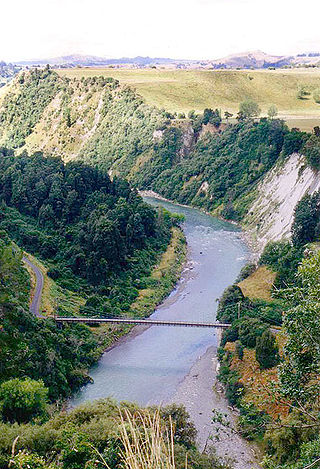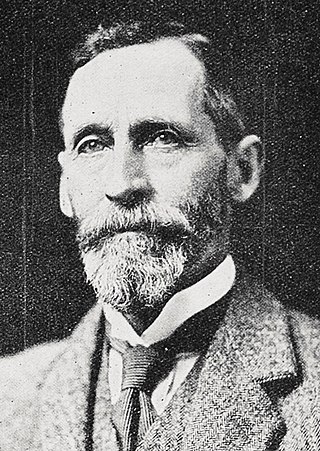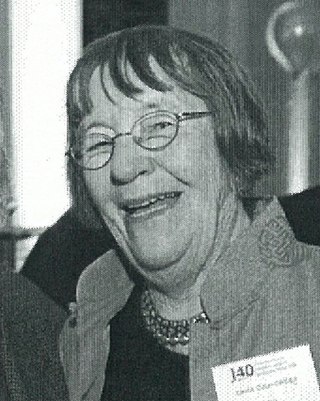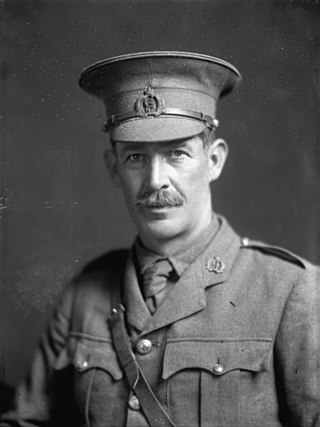Related Research Articles

The Australian and New Zealand Mounted Division was a mounted infantry division of the British Empire during World War I. The division was raised in March 1916 and was assigned to the I ANZAC Corps. On establishment, it consisted of four brigades comprising three Australian Light Horse and one New Zealand mounted rifles, supported by British horse artillery. In 1917, one of the Australian brigades was replaced by a British yeomanry brigade. After April 1917, the standard order of battle was reduced to two Australian brigades and one New Zealand brigade, although the Imperial Camel Corps Brigade and other British mounted brigades were temporarily attached several times during operations.

Tangimoana is a community in the Manawatū-Whanganui Region of the North Island of New Zealand. It had a population of 303 permanent residents in 2018. It is located 15 kilometres southwest of Bulls, and 30 kilometres west of Palmerston North.

The Rangitīkei River is one of New Zealand's longest rivers, 253 kilometres (157 mi) long.

The New Zealand Mounted Rifles Brigade was a brigade of the New Zealand Army during the First World War. Raised in 1914 as part of the New Zealand Expeditionary Force, it was one of the first New Zealand units to sail for service overseas.

Avondale Agricultural Research Station or Avondale Discovery Farm is one of thirteen research farms and stations operated by Western Australia's Department of Agriculture and Food. In addition to its research, Avondale has historical buildings, a farming equipment museum and operates as an agriculture education centre specialising in introducing primary school children to farming, and teaching of its history in Western Australia.

The Rangitikei by-election of 1978 was a by-election in the New Zealand electorate of Rangitikei, a predominantly rural district in the middle of New Zealand's North Island. The by-election occurred on 18 February 1978, and was precipitated by the death of sitting National Party member of parliament Sir Roy Jack in December 1977.

Arthur Gorbell Bignell was Mayor of Wanganui from 1904 to 1906, and a builder in Oamaru, the West Coast, Wanganui and the Rangitikei district.

The Canterbury Mounted Rifles Regiment was a mounted infantry regiment from New Zealand, raised for service during the First World War. It was assigned to the New Zealand Mounted Rifles Brigade, and formed part of the New Zealand Expeditionary Force.

Edward Newman was a Reform Party Member of Parliament and a member of the New Zealand Legislative Council in the early 20th century.
William Crooks was manager of Eastwoodhill Arboretum, Ngatapa, Gisborne, New Zealand from 1967 to 1974. For the previous forty years he was the assistant of William Douglas Cook, founder of the arboretum.

George Hamish Ormond Wilson was a New Zealand Member of Parliament representing the Labour Party, farmer, author and Chairman of the Historic Places Trust. He donated 30 acres of bush and his homestead to the Crown, which is now administered by the Manawatū District Council.
Edward Brice Killen Gordon was a New Zealand politician of the National Party.

Dame Christine McKelvie Cole Catley was a New Zealand journalist, publisher and author. She co-founded the Parents Centre movement and influenced broadcasting policy in New Zealand.
Ian Robert Flockhart McKelvie is a New Zealand politician. He represented the National Party in the New Zealand House of Representatives from 2011 to 2023.

Brigadier General William Meldrum was a New Zealand lawyer, farmer, military leader, magistrate and local politician.

Bushy Park Homestead is an Edwardian-era homestead located in the Bushy Park forest sanctuary, 8 km (5.0 mi) from Kai Iwi, in the Manawatū-Whanganui region of New Zealand. The homestead is registered as a Category I historic place by Heritage New Zealand.

Moawhango is a rural community in the northern part of Rangitikei District of the Manawatū-Whanganui region of New Zealand's North Island. It is situated 19 km north of Taihape and 91 km northeast of Marton. Nearby Moawhango are located Moawhango River and Lake Moawhango.

Ngamahanga is a rural community, in the northeastern part of Rangitikei District, in the Hawke's Bay region of New Zealand's North Island. The rest of the Rangitikei District is located in the Manawatū-Whanganui region.
Parewanui is a settlement situated southeast of Bulls in the North Island of New Zealand.
Charles Guy Powles, was an officer in the New Zealand Military Forces who served in the Second Boer War and the First World War.
References
- ↑ "Flock House Homestead". New Zealand Heritage List/Rārangi Kōrero. Heritage New Zealand . Retrieved 31 August 2009.
- ↑ "Memorial to Bess the horse". New Zealand History. Ministry of Culture & Heritage. Retrieved 3 August 2024.
- ↑ "Memorial to Bess". Heritage New Zealand. Retrieved 3 August 2024.
- ↑ Flock House History page [ permanent dead link ] on the Flockhouse website
- ↑ Sutton, Jessica (20 January 2010). "Old Flock to rock at A Low Hum". Manawatu Standard . Retrieved 30 September 2011.